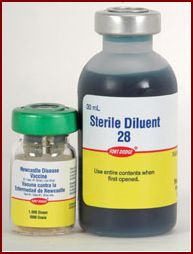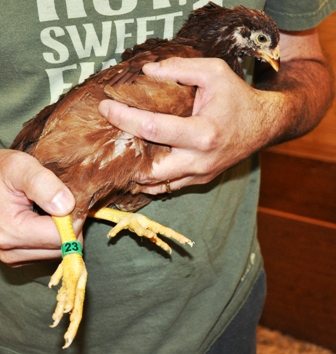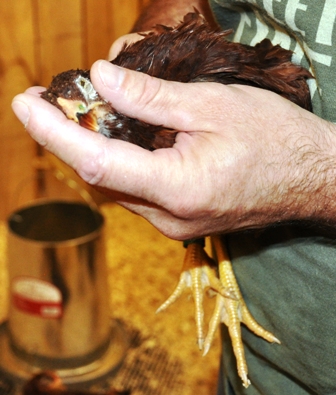In addition to practicing Biosecurity to protect chickens from disease, vaccination is an effective way to prevent or reduce specific diseases in poultry. Since we’ve had issues with Infectious Bronchitis (IB) in the past and it’s extremely contagious for poultry, we decided to vaccinate our chickens against it. Although we plan to maintain a small-closed flock thereby minimizing possible exposure, IB can “jump” relatively large distances, so we decided to vaccinate anyway. Anyone who takes birds to poultry shows, or buys from hatcheries or other sources and adds them to the flock; should definitely consider vaccinating for this and other common diseases. However, finding information on exactly “how-to” for a small flock seems difficult – this is what we ended up doing:
Obtaining Vaccine
For IB, live-virus vaccines are usually administered to young birds, and the IB vaccine is often combined with the Newcastle vaccine and given together. Unfortunately, the vaccine is usually produced in large quantities for commercial hatchery type applications – fortunately, the actual vaccine is relatively inexpensive even in the large quantities. We got our Newcastle-Bronchitis vaccine through Jeffers, and it was $4.99 for 1000 doses. We used the Newcastle (B1 Type, B1 Strain) – Bronchitis (Massachusetts and Connecticut Type) live-virus.

Handling Vaccine
The live-virus vaccine is shipped in a small, insulated cooler with a gel-ice pack to maintain refrigeration. It consists of two parts, the vial of vaccine and diluent, which must be stored separately in the refrigerator (in the dark) until administering the vaccine. When ready to administer, the entire vial of vaccine and diluent are mixed, used to vaccinate the chickens, and then the remaining contents must be disposed of.
Vaccinating the Birds
The vaccine can be given via drinking water, eye drop, or nose drop. We chose the nose drop as the easiest method for getting a known quantity reliably into each chicken. We administered the vaccine when the Buckeye chicks were 4 weeks old, 7 weeks old, and will administer again at 13 weeks. To administer, Randy would catch and hold each bird with one finger over the bird’s nostril, while I put a drop in the other nostril. As soon as the bird breathes, the vaccine is drawn into the nostril and you know the bird has successfully been vaccinated. At 7 weeks, we also banded the Buckeye chickens so we can begin evaluating them. Those we guessed were girls got green bands, while the boys got blue bands.

Effects of Vaccination
Live vaccines reproduce in the host to increase their numbers, and may produce symptoms in the host. In our case, the baby Buckeyes started sneezing about 3 – 4 days after their first vaccination, and continued for about a week. I felt so bad about vaccinating them, but they all quit sneezing and otherwise seemed no worse-off for having been vaccinated. After the second vaccination, we observed no effects. Now I just need to find information on whether they need to be re-vaccinated as adults, there seems to be conflicting information on whether it should or shouldn’t be done. If anyone knows, please leave a comment.

Maria Villa says
Thanks for sharing informative information. If anyone looking vaccination for chicken visit Proteon Pharma.
Tina says
I have what may be a stupid question about using a live vaccine. Since they were all exposed to the live virus. Are they all carriers now?